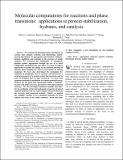| dc.description.abstract | In this work we have made significant contributions in three different areas of interest: therapeutic protein stabilization, thermodynamics of natural gas clathrate-hydrates, and zeolite catalysis. In all three fields, using our various computational techniques, we have been able to elucidate phenomena that are difficult or impossible to explain experimentally. More specifically, in mixed solvent systems for proteins we developed a statistical-mechanical method to model the thermodynamic effects of additives in molecular-level detail. It was the first method demonstrated to have truly predictive (no adjustable parameters) capability for real protein systems. We also describe a novel mechanism that slows protein association reactions, called the “gap effect.”
We developed a comprehensive picture of methioine oxidation by hydrogen peroxide that allows for accurate prediction of protein oxidation and provides a rationale for developing strategies to control oxidation. The method of solvent accessible area (SAA) was shown not to correlate well with oxidation rates. A new property, averaged two-shell water coordination number (2SWCN) was identified and shown to correlate well with oxidation rates.
Reference parameters for the van der Waals Platteeuw model of clathrate-hydrates were found for structure I and structure II. These reference parameters are independent of the potential form (unlike the commonly used parameters) and have been validated by calculating phase behavior and structural transitions for mixed hydrate systems. These calculations are validated with experimental data for both structures and for systems that undergo transitions from one structure to another. This is the first method of calculating hydrate thermodynamics to demonstrate predictive capability for phase equilibria, structural changes, and occupancy in pure and mixed hydrate systems.
We have computed a new mechanism for the methanol coupling reaction to form ethanol and water in the zeolite chabazite. The mechanism at 400°C proceeds via stable intermediates of water, methane, and protonated formaldehyde. | en |

